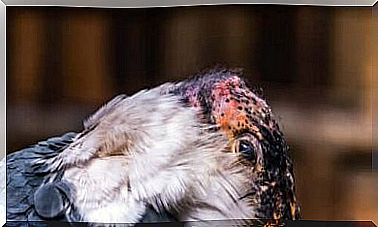5 Tips For Caring For A Deaf Cat

Taking care of a deaf cat can seem like a daunting task. In addition to his usual needs, he will have to learn new ways to communicate what he needs.
Although it sounds difficult, the reality is not that complicated. Cats and humans are very adaptable beings and, with some constancy, they can be understood without problems. In this article, we’ll give you five tips for caring for a cat with a hearing impairment.
the deaf cats
Some cats are born deaf and others are deaf throughout their lives. The most common cause of non-congenital deafness in cats is age. Other causes can be ear canal infections, such as ear infections.
There is evidence of a relationship between coat pigmentation in domestic cats and the incidence of congenital hearing disorders. Not all white cats are deaf, but blue-eyed white cats are more likely to have congenital deafness.

Symptoms of deafness in cats
To find out if your cat is or is becoming deaf, take him to the vet and pay attention to his behavior. A common symptom of deafness in cats is increased sleep time. This symptom can be a bit confusing, as cats love to sleep a lot.
A deaf cat may also appear more attentive. If you notice your cat’s unusual interest in you or other pets, he may be watching your movements more carefully.
Many deaf cats are aware of their behavior or that of other animals to know what is happening around them. Other common signs can be:
- Your cat doesn’t notice when you enter the house.
- Does not respond to everyday sounds such as being called by name, loud noises and squeaky toys.
- Don’t wake up with loud noises like the doorbell.
- Greater sensitivity to aromas and temperature.
These are some of the possible signs of deafness in cats. Remember, if in doubt, consult your veterinarian.
Tips for caring for a deaf cat
Despite its condition, a cat with a hearing impairment can make an excellent pet. In general, caring for a deaf cat is not much different from caring for a cat that hears well. We just need to take into account certain details that will make your life easier and make living easier.
1. Avoid scares
Cats that live indoors still retain their wild instincts that make them believe they are always being hunted. For this reason, it can be very stressful if you are always suddenly approaching your cat, even by accident.
It’s a good idea to use visual cues to tell your cat that you’re coming closer. If he’s asleep and you want to get his attention, be sure to give him some vibrations. Walk with strong stomps or clap your hands. The tremor will alert you to its presence.

2. Educate your deaf cat
Although they are slightly different, it is equally important to educate your deaf cat. As they are more attuned to visual stimuli, take the opportunity to use their body as a form of communication.
When he looks at you, lower yourself to the floor and reach out to call out to him. Strengthen your instincts by approaching him using a small treat.
You can stand up and wave your arms above your head as you approach to communicate your displeasure when he jumps onto the kitchen table, for example.
Also, you can teach a deaf cat not to jump on a table by using a spray bottle filled with water to wet it. A stream of water is not painful and attracts the cat’s attention if he is facing the other way. Furthermore, according to some experts, it can help correct the behavior without causing fear in the animal.
3. Keep your deaf cat safe
There are many outdoor threats to a deaf cat, so it’s important to take good care of them. They cannot hear dogs barking, horns or people screaming.
For these reasons, it ‘s important to provide a comfortable resting area beside a window where he can look out and see everything that’s going on. If you have enough space, it is ideal to have access to a cat cage in the backyard. There, he can breathe fresh air and see other animals.
It is also an option to teach him to walk with a leash. He’ll have a lot of fun walking around the neighborhood while keeping himself safe. He will learn faster than you think!

4. Find a company for him
All cats benefit from having other pets around them, especially other cats. This is especially true of deaf cats. In general, under these conditions, the cats will take cues from the behavior of other animals to know what is going on.
The ideal would be to have two cats from puppies to facilitate coexistence when the two are older. If you have a deaf cat and you want to bring a new companion, it’s important to make sure both of your personalities are compatible.
Also, you must understand that both will go through an adjustment period. This can take anywhere from a few days to months. If you make the right choice and provide them with adequate amounts of exercise, both cats will be happy to have a new friend.
5. Establish a routine
Cats are demanding creatures who love routine and confidence. This is even more true when your cat doesn’t have one of the senses. To avoid disorienting and causing stress, maintain a reliable meal routine and avoid rearranging furniture.
By creating a schedule and following it, you can quickly teach a cat important household routines. Your cats can learn when meals take place and where to feed.
Cats, deaf or not, remain happy pets. In general, making simple adjustments for a hearing-impaired animal is not difficult.
When you open your home to a hearing-impaired four-legged companion, you will discover an inseparable friend. You two will learn new ways to communicate!









